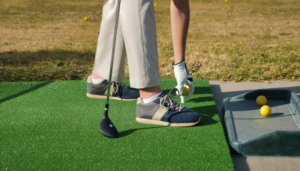Golf club length is essential when playing your best game on the course. Choosing the correct length for each club in your bag can impact your swing, accuracy, and distance. In this article, we will discuss the importance of golf club length, how it affects your game, and provide tips on how to fit your clubs properly.
What is Golf Club Length?
Golf club length refers to the distance from the grip’s end to the club head’s sole. The length of a golf club can vary depending on the type of club. For example, drivers and woods have longer shafts than irons, while wedges and putters have shorter shafts. The length of a golf club can also impact other factors, such as the lie angle and shaft flex.
Why is Golf Club Length Important?
Having the correct golf club length is crucial for a few reasons. First, it can impact your swing. A too long club can cause you to stand too far away from the ball, leading to erratic swings and a lack of control. A club that is too short can cause you to stand too close to the ball, leading to poor contact and a loss of distance.
Secondly, golf club length can impact your accuracy. If your club’s length is unsuitable for your swing, you may find it challenging to hit the ball straight and consistently. Lastly, golf club length can impact your distance. A club that is too long or short can affect your swing speed, resulting in a loss or gain in the distance.
Factors to Consider When Fitting Golf Club Length
There are a few factors to consider when fitting golf club length, including:
Wrist-to-Floor Measurement
One of the most important factors to consider when fitting golf club length is your wrist-to-floor measurement. This measurement is taken by standing upright with your arms at your sides, and measuring the distance from your wrist to the floor. This measurement can help you determine the appropriate length of your clubs.
Lie Angle
The lie angle of a golf club refers to the angle between the shaft and the club’s sole. A lie angle that is too flat or too upright can cause the club to either hook or slice the ball. The length of the club can also impact the lie angle, as a longer club will generally require a flatter lie angle.
Grip Size
The size of your grip can also impact the length of your golf club. If you have larger hands, you may need a larger grip, which can impact the length of your club. On the other hand, if you have smaller hands, you may require a smaller grip, which can also impact the length of your club.
Shaft Flex
The flex of your shaft can also impact the length of your club. A stiffer shaft may require a shorter club length, while a more flexible one may require a longer one.
Putter and Wedge Length
The length of your putter and wedges can also impact your game. A putter that is too long or too short can affect your stroke and accuracy on the green. Similarly, a too long or short wedge can impact your short game performance.
Types of Shafts: Graphite vs. Steel
Regarding golf club length, the type of shaft you choose can also make a difference. Graphite shafts tend to be lighter and more flexible than steel shafts. They can provide more distance and speed, making them a popular choice for beginners and seniors. On the other hand, steel shafts tend to be stiffer and more durable than graphite shafts. They can provide more accuracy and control, making them a popular choice for more experienced golfers.
Standard Club Lengths
While golf club lengths can vary depending on the golfer’s needs, there are standard lengths for each type of club. For example, the standard length for a driver is around 44 inches, while the standard length for a 7 iron is around 37 inches. These standard lengths can be a starting point for fitting your clubs.
Tips for Fitting Golf Club Length
Now that you understand the importance of golf club length and the factors to consider when fitting, here are some tips for finding the correct length for your clubs:
Get a Professional Fitting
The best way to ensure you have the correct golf club length is to get a professional fitting. A golf pro or club fitter can help you determine the appropriate length based on your swing, wrist-to-floor measurement, and other factors.
Use a Length Based on Your Height
As a general rule of thumb, taller golfers tend to require longer clubs, while shorter golfers require shorter clubs. If you don’t have the opportunity to get a professional fitting, you can use a chart that provides general recommendations based on your height.
Consider Your Swing Speed
You may benefit from a shorter club length if you have a slower swing speed. This can help you generate more clubhead speed and distance. Conversely, if you have a faster swing speed, you may benefit from a longer club length, which can help you control your shots.
Test Out Different Lengths
Suppose you can try different lengths to see what feels most comfortable and produces the best results. You can do this at a golf store or on the course with a friend’s clubs.
Final Thoughts
Golf club length is essential to consider when playing your best game. Having the correct length for each club can impact your swing, accuracy, and distance. When fitting golf club length, consider wrist-to-floor measurement, lie angle, grip size, shaft length flex, putter and wedge length, and shaft type. Remember that there are standard lengths for each type of club, but getting a professional fitting or testing out different lengths is essential to find what works best for you. By fitting your clubs properly, you can improve your game and enjoy playing more on the golf course.





























































